 L. Tom Perry Special Collections is pleased to announce the availability of a newly digitized collection: Female Relief Society record book (MSS SC 23). This collection contains one minute book of the Female Relief Society in Salt Lake City, Utah, which outlines the activities, resolutions and meetings of the society. The record was kept by Louisa R. Taylor, the society’s secretary, and includes entries for meetings from January 9-June 13, 1854. Some entries are also kept by assistant secretary Amanda Barnes Smith.
L. Tom Perry Special Collections is pleased to announce the availability of a newly digitized collection: Female Relief Society record book (MSS SC 23). This collection contains one minute book of the Female Relief Society in Salt Lake City, Utah, which outlines the activities, resolutions and meetings of the society. The record was kept by Louisa R. Taylor, the society’s secretary, and includes entries for meetings from January 9-June 13, 1854. Some entries are also kept by assistant secretary Amanda Barnes Smith.
The purpose of the group was to make clothing for the local Native American women and children. This was one of the first Relief Society organizations formed in Utah Territory, and is a predecessor to the official Relief Society organized by Brigham Young and Eliza R. Snow in 1855. A transcription of these minutes along with a historical note about this early Utah Relief Society group can be found as part of the online publication of The First Fifty Years of Relief Society (2008).
April 12, 2021 by Maggie Kopp
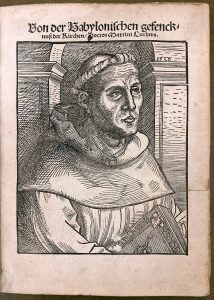
Portrait of Martin Luther by Lucas Cranach, 1520. Call number: Vault Collection 284.1 L97von 1520
When Charles V was crowned Holy Roman Emperor in October 1520, he was immediately confronted by urgent political, military, and social challenges within his new realm. He called an imperial council, or Diet, to be held in the city of Worms on the Upper Rhine in modern Germany. The council opened on January 23, 1521.
The issue of religious reform came up early in the council’s discussions. Many secular leaders within the empire were unhappy with perceived mismanagement and abuses by the Church, which Martin Luther had been openly preaching against. On the other hand, the Pope had excommunicated Luther and Church leaders urged Charles to suppress the growing religious unrest in German lands. But Charles would not be pushed into a hasty decision. On March 6 he issued a summons to Luther to appear before the council and granted him safe conduct on the journey from Wittenberg.
Luther arrived in Worms on April 16. The following afternoon, he appeared before the council. Luther was expecting to be invited to debate his ideas about Church reform. Instead, he was asked whether he wished to affirm or recant his published writing. Luther begged to be allowed to prepare a response. He returned to the council on April 18, telling them that he was willing to retract his work if someone could prove to him—based on scripture—that he was in error, but no one had satisfactorily pointed out where he was wrong.
Charles, unswayed by Luther’s response, resolved to ban him from preaching or writing and to proceed with heresy charges. But other members of the Diet wanted to further discuss the case, and to see whether Luther could truly be swayed by arguments from scripture. Charles could not issue a formal decree without the consensus of the Diet. While the council discussed his fate, Luther left for Wittenberg, under another letter of safe conduct. Frederick of Saxony, prince of Luther’s region of Germany, came to his aid by staging an abduction so that Luther could hide out until the scandal died down.
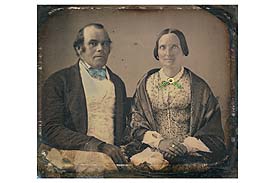
Parley P. Pratt (1807-1857) and Belinda Marden Pratt (1820-1894). Image Source: Jared Pratt Family Association website (http://photos.pratt-family.org/marden-cat/marden-cat-p1.html).
L. Tom Perry Special Collections is pleased to announce the availability of a newly digitized collection: Parley P. Pratt and Belinda Marden Pratt book of poetry and accounts (Vault MSS 725). This collection contains one notebook with poems by Parley P. and Belinda Marden Pratt. One poem deals with the martyrdom of the Prophet Joseph Smith. Also includes some financial accounting written in the same book. These poems were likely produced in Utah in 1847.
Belinda Marden Pratt was born Melinda Marden on December 24, 1820 in Chichester, New Hampshire to John Marden and Rachel Shaw. She was converted to The Church of Jesus Christ of Latter-day Saints in 1843. She was sealed to Parley P. Pratt on November 20, 1844 in Nauvoo, Illinois, as Pratt’s sixth wife. She moved to Utah and was an active member of the Church there, serving as Relief Society president of her ward and later her stake. For more about her work in the Relief Society, found in the book The First Fifty Years of Relief Society (2008), click here. Belinda Marden Pratt passed away February 19, 1894 in Salt Lake City, Utah.
Parley Parker Pratt, Sr. (1807-1857) was an early leader of the Latter Day Saint movement whose writings became a significant early nineteenth-century exposition of the Latter Day Saint faith. Named in 1835 as one of the first members of the Quorum of the Twelve Apostles, Pratt was part of the Quorum’s successful mission to Great Britain from 1839 to 1841. Pratt has been called “the Apostle Paul of Mormonism” for his promotion of distinctive Mormon doctrines. Pratt was a noted religious writer and poet. One of Pratt’s most influential works was a book entitled A Voice of Warning (1837), first published in New York City. Pratt’s most well-known theological work was A Key to Science of Theology, which was published in 1855. Pratt’s Visions and Poetry also serve as the text for many songs now found in the Latter Day Saint Hymnal. Pratt’s writings also corroborate many events and revelations which are found in a book of Latter Day Saint scripture known as the Doctrine and Covenants. In total, Pratt is known to have written 31 published works, not including his posthumous autobiography. Pratt explored and surveyed Parley’s Canyon in Salt Lake City, Utah (named in his honor), and subsequently built and maintained the first road for public transportation in the canyon. Pratt practiced plural marriage. He was murdered in 1857 by the Hector McLean, estranged husband of his twelfth wife, Eleanor McLean, while on a mission in Arkansas. (Source: Wikipedia)
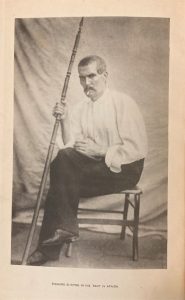 Today marks the 200th birthday of preeminent Victorian explorer, and prolific author, Sir Richard Francis Burton (1821-1890).
Today marks the 200th birthday of preeminent Victorian explorer, and prolific author, Sir Richard Francis Burton (1821-1890).
Burton had an amazing aptitude for languages and for blending in with foreign cultures, which he honed as a young English army officer. He served as an interpreter and spy in India, where he learned Arabic, Persian, and several Indian languages (biographers estimate that he ultimately mastered over 40 languages and dialects). After returning to England in 1849, he petitioned the Royal Geographical Society to support him on a risky adventure: making the hajj, or pilgrimage, to the Islamic holy cities of Mecca and Medina, then forbidden to non-Muslim Europeans. Armed with a command of Arabic and a deep familiarity with the religion and culture, he traveled to Egypt in April 1853 and disguised himself there for several months before embarking on the pilgrimage. He succeeded in reaching Medina in July 1853 and Mecca two months later. The notes he kept in secret were later published as A Personal Narrative of a Pilgrimage to Al-Madinah & Meccah (1855-56).
Burton lived or traveled on five continents. He made two dangerous expeditions in Somalia and the Central African Lakes after his hajj experience. Burton joined the British Foreign Service in 1861. He was posted to West Africa, Brazil, and Syria, publishing numerous accounts of his expeditions during these assignments. Burton’s 1860 trip to Canada and the United States included a visit to Salt Lake City, where he met Brigham Young. The City of the Saints and Across the Rocky Mountains to California, published in 1861, is one of the most famous 19th century travel accounts of territorial Utah and Mormonism.
Burton wrote over 40 books and countless articles during his lifetime. Besides his travel narratives, he made several translations of world literature, like Camoens’ The Lusiads, the Kama Sutra, and The Arabian Nights. He also published two volumes of his own verse, Stone Talk and The Kasidah.
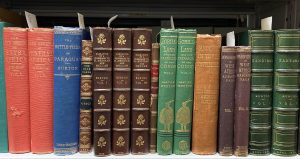 Special Collections owns an extensive collection of Burton’s writings as part of the Victorian Collection, as well as numerous editions of The City of the Saints in the Americana Collection. The Victorian Collection also owns copies of the published work of Burton’s wife, Isabel (1831-1896), who wrote a biography of her husband and published her own travel accounts and translations.
Special Collections owns an extensive collection of Burton’s writings as part of the Victorian Collection, as well as numerous editions of The City of the Saints in the Americana Collection. The Victorian Collection also owns copies of the published work of Burton’s wife, Isabel (1831-1896), who wrote a biography of her husband and published her own travel accounts and translations.
March is Women’s History Month, and today we examine three recent acquisitions of travel narratives written by women.
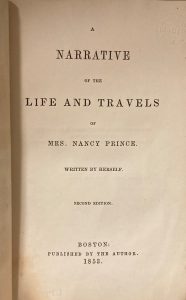 A Narrative of the Life and Travels of Mrs. Nancy Prince (1853). Nancy Gardner Prince was a free-born African-American woman from Massachusetts. She traveled to Russia with her husband, Nero Prince, who worked for several years as a footman at the czar’s court. After returning to the United States, Nancy went on two mission trips to Jamaica. She lectured and published on her travels as well as publishing several editions of this travel narrative.
A Narrative of the Life and Travels of Mrs. Nancy Prince (1853). Nancy Gardner Prince was a free-born African-American woman from Massachusetts. She traveled to Russia with her husband, Nero Prince, who worked for several years as a footman at the czar’s court. After returning to the United States, Nancy went on two mission trips to Jamaica. She lectured and published on her travels as well as publishing several editions of this travel narrative.
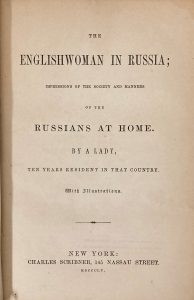 Another in-depth account of life in Russia is The Englishwoman in Russia: Impressions of the Society and Manners of the Russians at Home (1855). This work, by a pseudonymous “Lady,” has been attributed to Mrs. Andrew Neilson, the wife of an English businessman, but it has also been attributed to Sophia Lane Poole, author of The Englishwoman in Egypt, and to traveler and philanthropist Lady Judith Cohen Montefiore.
Another in-depth account of life in Russia is The Englishwoman in Russia: Impressions of the Society and Manners of the Russians at Home (1855). This work, by a pseudonymous “Lady,” has been attributed to Mrs. Andrew Neilson, the wife of an English businessman, but it has also been attributed to Sophia Lane Poole, author of The Englishwoman in Egypt, and to traveler and philanthropist Lady Judith Cohen Montefiore.
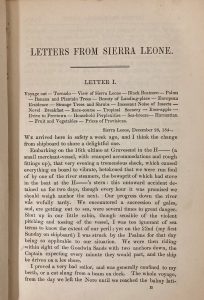 A Residence at Sierra Leone (1849) was compiled from the journal and letters of Elizabeth Helen Melville. Elizabeth and her husband Michael Melville lived in Freetown, Sierra Leone for many years while he worked in the British colonial government, including serving as a crown prosecutor fighting the slave trade and as Lieutenant Governor. Elizabeth’s book discusses her husband’s work as well as life and society in 19th century British West Africa.
A Residence at Sierra Leone (1849) was compiled from the journal and letters of Elizabeth Helen Melville. Elizabeth and her husband Michael Melville lived in Freetown, Sierra Leone for many years while he worked in the British colonial government, including serving as a crown prosecutor fighting the slave trade and as Lieutenant Governor. Elizabeth’s book discusses her husband’s work as well as life and society in 19th century British West Africa.
Special Collections contains a wealth of travel accounts by 19th century women in books and periodicals. These books and other accounts can be found in the library catalog by using the subject search using geographic place names in combination with the search string “description and travel.”
February 24, 2021 by Maggie Kopp
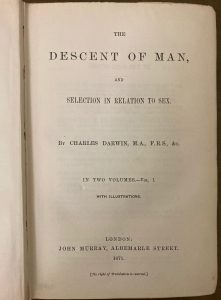 On this day 150 years ago, 24 February 1871, Charles Darwin’s The Descent of Man, and Selection in Relation to Sex was published by John Murray. On the Origin of Species had appeared 12 years earlier, introducing Darwin’s theory of evolution; with The Descent of Man, Darwin took the theory to its next logical conclusion by applying it to Homo sapiens. The Descent of Man actually marks the first time Darwin used the word “evolution” in print, on page 2 of the first volume. Murray issued 2500 copies in February 1871, but demand for the book was such that several thousand more copies were printed in March, April, and December of that year. Darwin was able to correct some minor printing errors in the various re-issues which help to distinguish the first issue from successive printings.
On this day 150 years ago, 24 February 1871, Charles Darwin’s The Descent of Man, and Selection in Relation to Sex was published by John Murray. On the Origin of Species had appeared 12 years earlier, introducing Darwin’s theory of evolution; with The Descent of Man, Darwin took the theory to its next logical conclusion by applying it to Homo sapiens. The Descent of Man actually marks the first time Darwin used the word “evolution” in print, on page 2 of the first volume. Murray issued 2500 copies in February 1871, but demand for the book was such that several thousand more copies were printed in March, April, and December of that year. Darwin was able to correct some minor printing errors in the various re-issues which help to distinguish the first issue from successive printings.
BYU Special Collections owns two copies of the first edition, first issue of The Descent of Man, which evidence a slight difference in height between the two copies. The second copy is of particular note due to its provenance. It was owned by Baroness Henrietta M. Stanley (1807-1895), a staunch 19th century advocate for women’s education. Baroness Stanley promoted the opening of the medical profession to women and was a founding patron of Girton College, the first women’s college at the University of Cambridge. Her signature, and a library shelfmark on the blank pages opening the first volume of her copy, are featured in the photograph below.
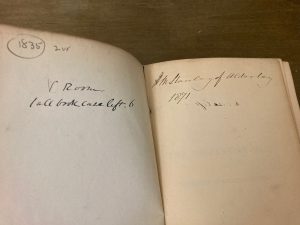
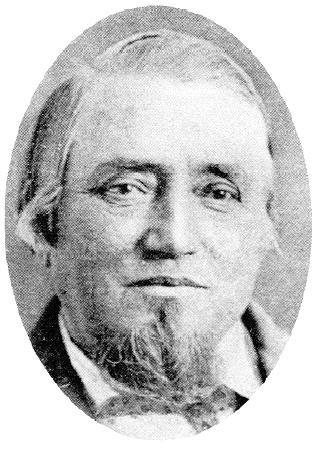
Thomas Bullock (1816-1885), clerk to Joseph Smith and Brigham Young
L. Tom Perry Special Collections is pleased to announce the availability of a newly digitized collection: Thomas Bullock papers (Vault MSS 772). This collections contains materials pertaining to the life and family members of Thomas Bullock, who served as clerk to both Joseph Smith (in Nauvoo) and Brigham Young (in Utah). The collection includes both personal and professional records, including journals, letters, financial records, certificates, genealogical data, partiarchal blessings, and poems. Bullock’s original journals document day to day life, spiritual experiences, and recorded historical moments while living in Nauvoo, Illinois, 1845-1846 and on the Mormon Trail in 1858. They are great sources for the final days of the Saints before the forced exodus from Nauvoo. A majority of the financial records concern Bullock’s family members. The poems included here were written by Eliza R. Snow for Thomas Bullock.
Thomas Bullock was born on December 23, 1816 as the youngest of nine children to Thomas and Mary Bullock in Leek, Staffordshire, England. At age thirteen, he began apprenticing as a clerk at a law office. In 1838, he began working in the government’s excise department and married Henrietta Rushton. They were baptized as members of the Church of Jesus Christ of Latter-day Saints in November of 1841. By 1843, Bullock and his family traveled to the United States to join the other Saints in Nauvoo, Illinois.
Thomas’s clerkship skills enabled him to serve as Joseph Smith’s personal clerk up through Joseph’s martyrdom. He later stayed behind to record the saints’ final days in Nauvoo before their mass exodus to Salt Lake City, Utah and then recorded their consequent pioneer trek west to Utah. He held numerous clerkship positions in Utah for the duration of his life, including clerking for Brigham Young and various projects for the Church.
Bullock practiced plural marriage. In addition to Henrietta, he married Lucy Clayton in 1846 and Betsy Prudence Howard in 1852. Thomas Bullock died in Coalville, Utah on February 10, 1885 leaving behind twenty-three children.
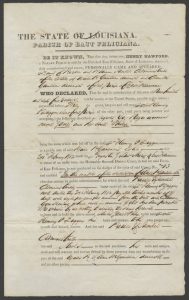
East Felicinia Parish bill of sale (MSS SC 1147)
As was recently announced, the Lee Library will be joining the national celebration of Douglass Day, named for Frederick Douglass whose birthday was February 14. Douglass Day is the precursor to Black History Month. Douglass Day will take place on February 12, 2021, and will include a transcribe-a-thon of historical documents related to Black history. This year they are transcribing the papers of Mary Church Terrell, founder of Douglass Day in 1897. If you want to participate in the transcribe-a-thon, visit this site: https://douglassday.org/.
While Perry Special Collections does not focus on collecting documents specifically related to Black history, we have collected some over time. Most of these are related to the tragic story of the enslavement of Black Africans in early America. We acknowledge that this is an unfortunate and terrible blotch on America’s history. Our hope is that by ensuring this history is well documented and accessible, future generations can learn from past mistakes. In this vein, we are doing our part to join in this celebration by releasing for transcription on Douglass Day (February 12) a small selection of recently digitized 18th and 19th century documents related to Black history!
If you are interested in helping to transcribe these items, visit the BYU Transcribe website. Anyone can participate, but you will need a BYU NetID. If you do not already have one, you can create one by filling out a form here.
Here is a sneak peek at some of the documents from Perry Special Collections that will be available to transcribe on February 12:
January 23, 2021 by Maggie Kopp
The winter of 1520-1521 marked a crucial turning point in the theological conflict between Martin Luther and the papacy. Pope Leo X issued an official decree (or “Bull”), Exsurge Domine on June 15, 1520 which condemned Luther and his teachings. Luther received a copy of the decree in October. It gave him 60 days to recant. Instead, Luther wrote more tracts against the Pope, and on December 10, he burned the decree in public.
Both the Pope and the newly-elected Holy Roman Emperor, Charles V, felt that something needed to be done about Luther. The Pope formally excommunicated him on January 3, 1521, and asked Charles to enforce civil penalties. The Holy Roman Empire held a regular council, or “Diet,” to settle disputes between various states in the empire, which opened on January 23, five hundred years ago. Luther was summoned to appear before the Diet, though he would not arrive until April. He expected to be able to debate his ideas before the civil and ecclesiastical authorities, unaware he was on a collision course with the Emperor and Pope who wanted him to recant his beliefs.
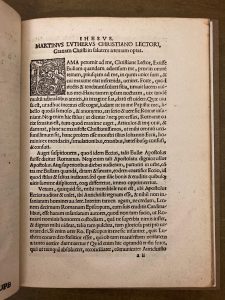
Special Collections owns copies of many of Luther’s writings from the winter of 1520-1521, including his polemical response to the papal decree, entitled “Against the Execrable Bull of the Antichrist” (shown here) and more conciliatory writings like “On the Freedom of a Christian.” To find more key works by Martin Luther, visit the Renaissance and Reformation Collection page or search the library’s catalog.
This winter, the L. Tom Perry Special Collections salutes the work of modern fine printers and artists working with the book as a medium with a small case exhibit titled “A Printer Wonderland.”
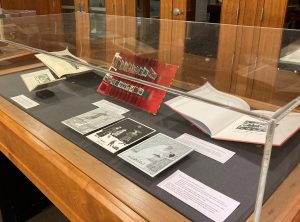 It has been common practice for many modern fine printers to produce small keepsakes at Christmas or New Year’s, including cards, broadsides, and pamphlets. This exhibit gathers some delightful examples, like the Christmas stamp flag book and Edward Gorey holiday cards in the case pictured above, as well as winter-themed stories and poems published by fine press artists working in the United States, Canada, and United Kingdom.
It has been common practice for many modern fine printers to produce small keepsakes at Christmas or New Year’s, including cards, broadsides, and pamphlets. This exhibit gathers some delightful examples, like the Christmas stamp flag book and Edward Gorey holiday cards in the case pictured above, as well as winter-themed stories and poems published by fine press artists working in the United States, Canada, and United Kingdom.
The exhibit will be in Special Collections’ lobby through the end of January.
 L. Tom Perry Special Collections is pleased to announce the availability of a newly digitized collection: Female Relief Society record book (MSS SC 23). This collection contains one minute book of the Female Relief Society in Salt Lake City, Utah, which outlines the activities, resolutions and meetings of the society. The record was kept by Louisa R. Taylor, the society’s secretary, and includes entries for meetings from January 9-June 13, 1854. Some entries are also kept by assistant secretary Amanda Barnes Smith.
L. Tom Perry Special Collections is pleased to announce the availability of a newly digitized collection: Female Relief Society record book (MSS SC 23). This collection contains one minute book of the Female Relief Society in Salt Lake City, Utah, which outlines the activities, resolutions and meetings of the society. The record was kept by Louisa R. Taylor, the society’s secretary, and includes entries for meetings from January 9-June 13, 1854. Some entries are also kept by assistant secretary Amanda Barnes Smith.

 Today marks the 200th birthday of preeminent Victorian explorer, and prolific author, Sir Richard Francis Burton (1821-1890).
Today marks the 200th birthday of preeminent Victorian explorer, and prolific author, Sir Richard Francis Burton (1821-1890). Special Collections owns an extensive collection of Burton’s writings as part of the Victorian Collection, as well as numerous editions of The City of the Saints in the Americana Collection. The Victorian Collection also owns copies of the published work of Burton’s wife, Isabel (1831-1896), who wrote a biography of her husband and published her own travel accounts and translations.
Special Collections owns an extensive collection of Burton’s writings as part of the Victorian Collection, as well as numerous editions of The City of the Saints in the Americana Collection. The Victorian Collection also owns copies of the published work of Burton’s wife, Isabel (1831-1896), who wrote a biography of her husband and published her own travel accounts and translations. A Narrative of the Life and Travels of Mrs. Nancy Prince (1853). Nancy Gardner Prince was a free-born African-American woman from Massachusetts. She traveled to Russia with her husband, Nero Prince, who worked for several years as a footman at the czar’s court. After returning to the United States, Nancy went on two mission trips to Jamaica. She lectured and published on her travels as well as publishing several editions of this travel narrative.
A Narrative of the Life and Travels of Mrs. Nancy Prince (1853). Nancy Gardner Prince was a free-born African-American woman from Massachusetts. She traveled to Russia with her husband, Nero Prince, who worked for several years as a footman at the czar’s court. After returning to the United States, Nancy went on two mission trips to Jamaica. She lectured and published on her travels as well as publishing several editions of this travel narrative. Another in-depth account of life in Russia is The Englishwoman in Russia: Impressions of the Society and Manners of the Russians at Home (1855). This work, by a pseudonymous “Lady,” has been attributed to Mrs. Andrew Neilson, the wife of an English businessman, but it has also been attributed to Sophia Lane Poole, author of The Englishwoman in Egypt, and to traveler and philanthropist Lady Judith Cohen Montefiore.
Another in-depth account of life in Russia is The Englishwoman in Russia: Impressions of the Society and Manners of the Russians at Home (1855). This work, by a pseudonymous “Lady,” has been attributed to Mrs. Andrew Neilson, the wife of an English businessman, but it has also been attributed to Sophia Lane Poole, author of The Englishwoman in Egypt, and to traveler and philanthropist Lady Judith Cohen Montefiore. A Residence at Sierra Leone (1849) was compiled from the journal and letters of Elizabeth Helen Melville. Elizabeth and her husband Michael Melville lived in Freetown, Sierra Leone for many years while he worked in the British colonial government, including serving as a crown prosecutor fighting the slave trade and as Lieutenant Governor. Elizabeth’s book discusses her husband’s work as well as life and society in 19th century British West Africa.
A Residence at Sierra Leone (1849) was compiled from the journal and letters of Elizabeth Helen Melville. Elizabeth and her husband Michael Melville lived in Freetown, Sierra Leone for many years while he worked in the British colonial government, including serving as a crown prosecutor fighting the slave trade and as Lieutenant Governor. Elizabeth’s book discusses her husband’s work as well as life and society in 19th century British West Africa. On this day 150 years ago, 24 February 1871, Charles Darwin’s The Descent of Man, and Selection in Relation to Sex was published by John Murray. On the Origin of Species had appeared 12 years earlier, introducing Darwin’s theory of evolution; with The Descent of Man, Darwin took the theory to its next logical conclusion by applying it to Homo sapiens. The Descent of Man actually marks the first time Darwin used the word “evolution” in print, on page 2 of the first volume. Murray issued 2500 copies in February 1871, but demand for the book was such that several thousand more copies were printed in March, April, and December of that year. Darwin was able to correct some minor printing errors in the various re-issues which help to distinguish the first issue from successive printings.
On this day 150 years ago, 24 February 1871, Charles Darwin’s The Descent of Man, and Selection in Relation to Sex was published by John Murray. On the Origin of Species had appeared 12 years earlier, introducing Darwin’s theory of evolution; with The Descent of Man, Darwin took the theory to its next logical conclusion by applying it to Homo sapiens. The Descent of Man actually marks the first time Darwin used the word “evolution” in print, on page 2 of the first volume. Murray issued 2500 copies in February 1871, but demand for the book was such that several thousand more copies were printed in March, April, and December of that year. Darwin was able to correct some minor printing errors in the various re-issues which help to distinguish the first issue from successive printings.



 It has been common practice for many modern fine printers to produce small keepsakes at Christmas or New Year’s, including cards, broadsides, and pamphlets. This exhibit gathers some delightful examples, like the Christmas stamp flag book and Edward Gorey holiday cards in the case pictured above, as well as winter-themed stories and poems published by fine press artists working in the United States, Canada, and United Kingdom.
It has been common practice for many modern fine printers to produce small keepsakes at Christmas or New Year’s, including cards, broadsides, and pamphlets. This exhibit gathers some delightful examples, like the Christmas stamp flag book and Edward Gorey holiday cards in the case pictured above, as well as winter-themed stories and poems published by fine press artists working in the United States, Canada, and United Kingdom.